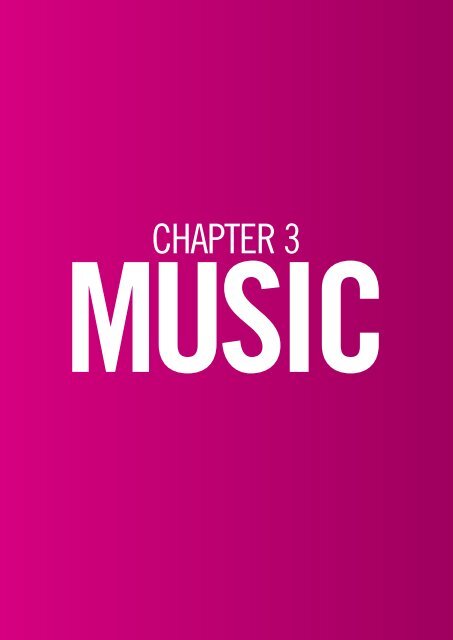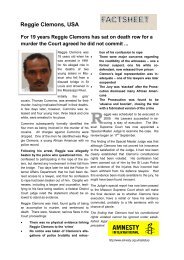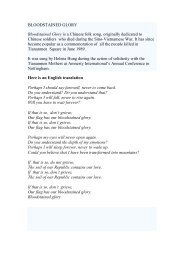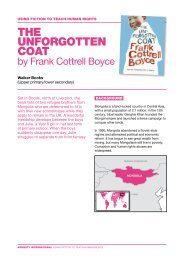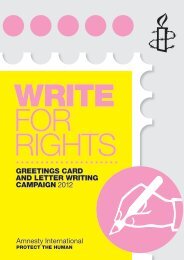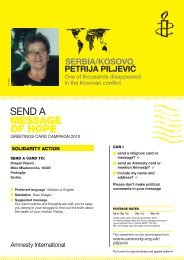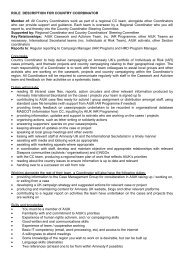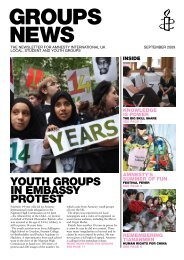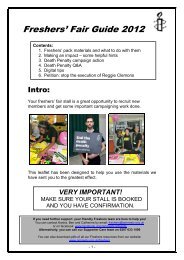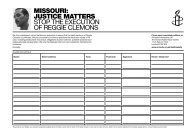Chapter 3: Music - Amnesty International
Chapter 3: Music - Amnesty International
Chapter 3: Music - Amnesty International
You also want an ePaper? Increase the reach of your titles
YUMPU automatically turns print PDFs into web optimized ePapers that Google loves.
CHAPTER 3<br />
mUSIC
CHAPTER 3<br />
mUSIC
INTRODUCTION<br />
We recommend that teachers devote one class to chapter one, human rights exercises, before they embark on this<br />
chapter. Each separate class or exercise has clearly outlined aims, objectives, length and NCCA key skills. We have also<br />
highlighted the material needed for each class or exercise. All handouts referenced in the classes can be found in the<br />
handout section at the end of this chapter.<br />
mUSIC AND hUmAN RIghTS<br />
<strong>Music</strong> is often regarded as universal, a common language understood by all. In the same way, human rights, defined in<br />
the Universal Declaration of Human Rights adopted by the United Nations in 1948, must be considered universal,<br />
regardless of culture, religion or socio-political context. Numerous musicians over the years have found an important<br />
source of inspiration in human rights issues. Sometimes the dismay engendered by violations of human rights has<br />
provoked the composer’s musical creativity. At other times it is the celebration of these rights that has been the<br />
driving force.<br />
<strong>Music</strong> encourages students to explore different perspectives. In composing the lyrics of a song the students takes on the<br />
role of a character, for example, a person being oppressed or excluded. This ensures that the students explores that<br />
person’s point of view, background or situation. <strong>Music</strong> inspired by human rights also encourages critical thinking.<br />
OVERALL AIm OF ThE SECTION<br />
Students will expand their knowledge of human rights issues, familiarise themselves with using song as a medium to<br />
explore human rights and engage with the process of creating a song.<br />
Liam Ó Maonlaí and St.Peter’s College Dunboyne, Co.Meath, Ireland 2008. © <strong>Amnesty</strong> <strong>International</strong>.<br />
MUSIC Introduction<br />
73
MUSIC Introduction<br />
74<br />
<strong>Music</strong> And The Voice Our Concern Programme 2008<br />
Artist Liam Ó Maonlaí<br />
“To celebrate the Universal Declaration of Human Rights I was asked by <strong>Amnesty</strong> <strong>International</strong> to participate in a<br />
project involving a school St Peter’s in Dunboyne. The object was to prepare a piece for a performance on the first of<br />
May in the Helix. The class I met was a happy one. That was my first impression. They were awake and interested.<br />
They were no fools and they had their own sense of humour. I respect anyone who has chosen the life of a teacher. It<br />
can be intense. Not for the fainthearted. These are young people with their own interests and insights. Who am I to be<br />
coming in to their world? One name I remember is Audrey. On the first day I asked a few of them to sing or play. She<br />
had no inhibition and sang with a calm confidence. I knew she could carry a song. I knew I could count on<br />
her leadership.<br />
On my second visit we threw out the bones of a song. I suggested ‘let them know that we hear’. This was in the form<br />
of a call and response prison style song. They took a hold of the idea straight away. I felt the tone had to be simple<br />
but strong. This worked. In no time they had two verses written. Together we arranged two other sections. By the third<br />
visit they were singing and playing with confidence. Each time I left St Peter’s I felt elated. Teaching I believe is a very<br />
important part of the development of a person. You are not truly a master until you can teach your craft. I feel<br />
confident for the future of this interesting little island knowing the character of her people is resonating still in her<br />
youth. I am looking forward to performing again with the music class and human rights group of St Peter’s<br />
Dunboyne. They Rock!”<br />
Liam Ó Maonlaí.<br />
U2 announce Ang Sang Suu Kyi as the Ambassador of Conscience at their concert. Dublin, Ireland. July 2009. © <strong>Amnesty</strong> <strong>International</strong>.
CLASS 1<br />
hUmAN RIghTS ThROUgh SONg<br />
AIM<br />
Students will learn how song can be a powerful tool when advocating for human rights.<br />
OBJECTIVES<br />
Students will have<br />
• Been introduced to the use of songs in social movements to secure human rights;<br />
• Reviewed the history of the Anti-Apartheid Movement through a brief lecture;<br />
• Researched cases in Ireland where songs were used to promote human rights for all, as a part of social move<br />
ments;<br />
• Compared and contrast the lyrics of selected songs;<br />
• Analysed why songs are powerful tools in political movements.<br />
NCCA KEY SKILLS<br />
Information processing, communication, critical and creative thinking and group work.<br />
MATERIAL NEEDED<br />
All materials are from the handout section associated with this chapter.<br />
Tape/CD player to play one of the songs.<br />
Anti-Apartheid timeline (handout section 3.1, pg 82).<br />
Anti-Apartheid songs (handout section 3.2, pg 84).<br />
UDHR Statement (<strong>Chapter</strong> 1, 1.1, pg 34).<br />
LENGTH<br />
Full Class<br />
STEPS:<br />
1. As students enter the room, play a protest song, such as Redemption Song or Get Up, Stand Up by Bob Marley<br />
or Imagine by John Lennon, to prompt students’ interest in the lesson. Hand out the lyrics so that the students<br />
can follow the song.<br />
2. Discussion Questions:<br />
• Is there a political message in the song, and, if so, what is the message?<br />
• Does the song advocate change?<br />
• Does the song inspire action? (Use the song as an introduction to protest music, and the power of music to<br />
motivate action).<br />
3. Ask students to brainstorm a list of protest songs or songs that inspired change. The students should explain how<br />
the lyrics informed them about an event or motivated change. As a class, develop a definition of protest music.<br />
MUSIC Classes<br />
75
MUSIC Classes<br />
76<br />
Class 1 Case Study<br />
The Anti-Apartheid Movement And Protest Songs<br />
STEPS:<br />
1. Hand out the Anti-Apartheid timeline provided. Ask the students to read through it. See handout section;<br />
2. Hand out two songs from the Anti-Apartheid movement, ask the students to read them. See handout section;<br />
3. Ask the students to analyze, compare, and contrast the lyrics. What are the similarities between the songs? What<br />
are the differences? What might the role of the song have been in the movement?<br />
4. Explain how the Anti-Apartheid movement relied on music to unify, uplift and motivate those who were struggling<br />
for equality;<br />
5. Hand out a copy of the UDHR and ask the students to look at it. What rights are both examined in the songs and<br />
protected in the declaration?<br />
Follow Up<br />
At the end of the class ask the students to go off and research a case in Ireland that has used or uses music to<br />
highlight human rights abuses or music that was written as a tool for social change. The students should research the<br />
political and historical impetus for the song, and the ways in which the song was used in the movement. The students<br />
can present the research to the class. (Such as, U2 by Sunday Bloody Sunday, Zombie, by the Cranberries, Streets of<br />
Sorrow by the Pogues and Go, move, shift sung by Christy Moore)<br />
CLASS 2<br />
ThE pOWER OF SONg:<br />
A ChILD SOLDIER’S STORy<br />
AIM<br />
Students will expand their knowledge of human rights issues and engage with the process of creating a song.<br />
OBJECTIVES<br />
Students will have<br />
• Learned about the Sudanese Conflict, the plight of child soldiers and the human rights document that deals<br />
with protecting these soldiers;<br />
• Developed songs about human rights issues in their own lives, and drawn connections between the songs<br />
studied in the unit and the songs they developed.<br />
NCCA KEY SKILLS<br />
Communication, information processing, critical and creative thinking and being personally effective.<br />
MATERIAL NEEDED<br />
Lyrics of Emmanuel Jal’s War Child (handout section 3.3, pg 86).<br />
Child Soldiers (handout section 3.4, pg 87).<br />
Optional Protocols (handout section 3.5, pg 88).<br />
LENGTH<br />
Full Class
The Power Of Song: Emmanuel Jal<br />
STEPS:<br />
1. Hand out to the students Emmanuel Jal’s Story and the piece about Child Soldiers and the lyrics to his song,<br />
(handout section 3.4, pg 87)<br />
2. Ask one of the students to read out Emmanuel Jal’s lyrics.<br />
Discussion Questions<br />
• What is the song trying to say?<br />
• Did Emmanuel Jal have a choice in his decision to become a child soldier?<br />
• What human rights violations did Emmanuel Jal suffer when you compare his story to the rights in the UDHR?<br />
• Read to the students some of the Optional Protocol on the Involvement of Children in Armed Conflict<br />
(handout section 3.5, pg 88). Ask them to reflect upon Emmanuel Jal’s Story and the rights contained in the<br />
Optional Protocol.<br />
Follow Up<br />
Tell the students’ to go to www.amnesty.ie and look at some of the human rights campaigns that <strong>Amnesty</strong><br />
<strong>International</strong> Ireland are working on today, such as our campaign on the right to housing, or right to healthcare, or<br />
our campaign to end the death penalty. Ask the students to begin to develop their own song about a human rights<br />
issue that is important to them. You should make sure that permission has been given by parents for students to use<br />
the Internet. If students don’t have access to the Internet at home, they can go to a local library or where possible<br />
use the school’s internet.<br />
Thousands of bullet holes riddle the facade of this school and remind returnees in Yei of their painful past, Sudan 2005. © UNHCR M. Pearson.<br />
MUSIC Classes<br />
77
MUSIC Classes<br />
78<br />
CLASS 3<br />
ChRISTy mOORE’S SONg ON<br />
TRAVELLERS’ RIghTS<br />
AIM<br />
Learn about an Irish human rights issue through song.<br />
OBJECTIVES<br />
Students will have<br />
• Been introduced to the human rights inspired song of Christy Moore;<br />
• Increased an understanding of how music can be used as a tool for expressing human rights concerns;<br />
• Used song to explore human rights issues.<br />
NCCA KEY SKILL<br />
Communication, information processing, critical and creative thinking and being personally effective.<br />
MATERIAL NEEDED<br />
Johnny Connors by Christy Moore (handout section 3.6, pg 89).<br />
Factsheet on Travellers’ Rights (handout section 3.7, pg 90).<br />
LENGTH<br />
Full Class<br />
STEPS:<br />
1. Read through Johnny Connors by Christy Moore and begin discussing questions; (handout section 3.6, pg 89)<br />
2. Hand out the factsheet on Travellers’ rights.<br />
Discussion Questions<br />
• Why do you think Christy Moore wrote this song?<br />
• What is the song trying to say?<br />
• What is your favourite line in the song? Why?<br />
• From the lyrics of this song make a list of the Travellers’ rights violated.
Christy Moore and Castleknock Community College, Dublin, Ireland 2008. © <strong>Amnesty</strong> <strong>International</strong>.<br />
CLASS 4<br />
WRITE yOUR OWN hUmAN RIghTS<br />
INSpIRED SONg<br />
AIM<br />
Students will learn how Transition Year students from other schools translated their human rights concerns into<br />
songs.<br />
OBJECTIVES<br />
Students will have<br />
• Appreciated the work of peer students who wrote their own songs about human rights;<br />
• Brought their own writing skills to human rights issues;<br />
• Critically engaged and evaluated the meanings behind the lyrics.<br />
NCCA KEY SKILLS<br />
Communication, information processing, critical and creative thinking and being personally effective.<br />
MATERIAL NEEDED<br />
Songs and the comments from VOC music project 2008 (handout section 3.8, pg 91).<br />
Guidelines on how to write a song (handout section 3.9, pg 94).<br />
CRE case study (handout section 3.10, pg 95).<br />
LENGTH<br />
Full Class<br />
MUSIC Classes<br />
79
MUSIC Classes<br />
80<br />
STEPS:<br />
1. Hand out or read out some of the comments from the VOC participants 2008, see hand out section;<br />
2. Hand out the lyrics of the VOC songs, see handout section;<br />
3. Study these songs. Ask the students:<br />
Discussion Questions<br />
• Are they informative about the views they are portraying?<br />
• Do they deliver a political message?<br />
• What was the message behind the lyrics?<br />
• Ask some of the students to present/talk about the song that they had begun for homework.<br />
CLASSROOM ACTIVITY:<br />
WRITE THE LYRICS TO A SONG.<br />
STEPS:<br />
1. Hand out the guidelines on creating a song written by participants of the Voice Our Concern 2008 music project;<br />
2. Once students have read these ask them to write the lyrics to a human rights inspired song.<br />
Follow Up<br />
Ask the students to finish their songs about human rights. Invite the students to share their songs or poems at the end<br />
of the next class period. Ask students who play musical instruments to add music to their songs, and to bring in their<br />
instruments to class.
HANDOUTS<br />
mUSIC
MUSIC Handouts<br />
82<br />
hANDOUT 3.1<br />
ThE ANTI-ApARThEID<br />
TImELINE<br />
This handout is used in the following classes/exercises<br />
Class 1: Human Rights through Song / pg.75<br />
1651<br />
1810s<br />
1908<br />
1912<br />
1913<br />
1936<br />
1946<br />
1950<br />
1951<br />
1953<br />
1955<br />
1960<br />
Dutch settlers arrive in South Africa. In 1756, they brought in slaves from West Africa, Malaysia, and<br />
India, establishing the dominance of whites over non-whites in the region.<br />
British missionaries arrive and criticize the racist practices of the Boers. They urge the Boers to treat the<br />
Africans more fairly. Boers justify their practices in the belief that they are superior to Africans.<br />
A constitutional convention is held to establish South African independence from Britain. The all-white<br />
government decides that non-whites can vote but cannot hold office. The South Africa Act takes away all<br />
political rights of Africans in three of the country’s four states.<br />
The African National Congress (ANC) is formed. This political party aims to organize Africans in the<br />
struggle for civil rights.<br />
The Native Lands Act gives 7.3% of the country’s land to Africans, who make up 80% of the population.<br />
Africans are prohibited from owning land outside their region. Africans are allowed to be on white land<br />
only if they are working for whites.<br />
By 1939, fewer than 30% of Africans are receiving any formal education, and whites are earning over<br />
five times as much as Africans.<br />
Representation of Voters Act. This law weakens the political rights for Africans in some regions and allows<br />
them to vote only for white representatives.<br />
African mine workers are paid twelve times less than their white counterparts and are forced to do the<br />
most dangerous jobs. Over 75,000 Africans go on strike for higher wages. Police use violence to force<br />
the unarmed workers back to work. Over 1,000 workers are injured or killed.<br />
The Population Registration Act. This law classifies people into three racial groups: white, colored (mixed<br />
race or Asian), and native (African/black). Marriages between races are outlawed in order to maintain<br />
racial purity.<br />
The Group Areas Act sets aside specific communities for each of the races white, colored (mixed race or<br />
Indian), and native (African/black) ). Non-whites are relocated into “reserves.” Mixed-race families are<br />
forced to live separately.<br />
The Bantu Homelands Act. Through this law, the white government declares that the lands reserved<br />
for black Africans are independent nations. In this way, the government strips millions of blacks of their<br />
South African citizenship and forces them to become residents of their new “homelands.” Blacks are<br />
now considered foreigners in white-controlled South Africa, and need passports to enter. Blacks only<br />
enter to serve whites in menial jobs.<br />
The Preservation of Separate Amenities Act establishes “separate but not necessarily equal” parks,<br />
beaches, post offices, and other public places for whites and non-whites.<br />
African National Congress (ANC), issues a Freedom Charter that states, “South Africa belongs to all who<br />
live in it, black and white, and that no government can justly claim authority unless it is based on the will<br />
of the people.” The government reacts by arresting people and passing more repressive laws.<br />
A large group of blacks in the town of Sharpeville refused to carry their passes (required by the government<br />
these identification booklets list their names, addresses, fingerprints, and other information). The<br />
government declares a state of emergency and responds with fines, imprisonment, and whippings. In<br />
all, 69 people die and 187 people are wounded. The African political organizations, the African National<br />
Congress and the Pan-African Congress, are banned.
1962<br />
1963<br />
1970s<br />
1970s<br />
1980s<br />
1980s<br />
1991<br />
1991<br />
1994<br />
Source: www.un.org<br />
The United Nations establishes the Special Committee Against Apartheid to support a political process<br />
of peaceful change. The Special Committee observes the <strong>International</strong> Day Against Racism to mark the<br />
anniversary of the people who died in the Sharpeville protest.<br />
Nelson Mandela, head of the African National Congress, is jailed.<br />
Resistance to apartheid increases. Organizing by churches and workers increases. Whites join blacks in<br />
the demonstrations.<br />
The all-black South African Students Organization, under the leadership of Steven Biko, helps unify<br />
students through the Black Consciousness movement.<br />
People and governments around the world launch an international campaign to boycott (not do<br />
business with) South Africa. Some countries ban the import of South African products, and citizens of<br />
many countries pressure major companies to pull out of South Africa.<br />
Countries around the world increasingly pressure South Africa to end its system of apartheid. As a result,<br />
some of the segregationist laws are repealed (reversed). For example, the laws separating whites and<br />
non-whites in public places are relaxed or repealed.<br />
South Africa President F.W. de Klerk repeals the rest of the apartheid laws and calls for the drafting of a<br />
new constitution.<br />
A multiracial, multiparty transitional government is approved.<br />
Elections are held. The United Nations sends 2,120 international observers to ensure the fairness of the<br />
elections. The African National Congress, representing South Africa’s majority black population came to<br />
power. Nelson Mandela, the African resistance leader who had been jailed for 27 years, is<br />
elected President.<br />
MUSIC Handouts<br />
83
MUSIC Handouts<br />
84<br />
hANDOUT 3.2<br />
ANTI-ApARThEID SONgS<br />
This handout is used in the following classes/exercises<br />
Class 1: Human Rights through Song / pg.75<br />
Nelson Mandela<br />
Free Nelson Mandela<br />
Free, Free, Free Nelson Mandela<br />
Free Nelson Mandela<br />
Twenty-one years in captivity<br />
His shoes too small to fit his feet<br />
His body abused, but his mind is still free<br />
Are you so blind that you cannot see?<br />
I say Free Nelson Mandela<br />
I’m begging you<br />
Free Nelson Mandela<br />
He pleaded the causes of the ANC<br />
Only one man in a large army<br />
Are you so blind that you cannot see?<br />
Are you so deaf that you cannot hear this plea?<br />
Free Nelson Mandela<br />
I’m begging you<br />
Free Nelson Mandela
Amandla Awethu!<br />
(Power to the People)<br />
The great flood of tears that we’ve cried<br />
For our brothers and sisters who’ve died<br />
Over four hundred years<br />
Has washed away our fears<br />
And strengthened our pride<br />
Now we turn back the tide<br />
We will no longer hear your command<br />
We will seize the control from your hand<br />
We will fan the flame<br />
Of our anger and pain<br />
And you’ll feel the shame<br />
For what you do in God’s name<br />
We will fight for the right to be free<br />
We will build our own society<br />
And we will sing, we will sing<br />
We will sing our own song<br />
When the ancient drum rhythms ring<br />
The voice of our forefather sings<br />
Forward Africa run<br />
Our day of freedom has come<br />
For me and for you<br />
Amandla Awethu!<br />
MUSIC Handouts<br />
85
MUSIC Handouts<br />
86<br />
hANDOUT 3.3<br />
War Child<br />
By Emmanuel Jal<br />
This handout is used in the following classes/exercises<br />
Class 2: The Power Of Song: A Child Soldier’s Story / pg.76<br />
I believe I’ve survived for a reason to tell my story to touch lives<br />
I believe I’ve survived for a reason to tell my story to touch lives<br />
All the people struggling down there<br />
Storms only come for a while<br />
Then after a while they’ll be gone<br />
Blessed, blessed<br />
My father was working for the government as a policeman<br />
Few years later a hardy joined a rebel movement that was formed to fight for freedom<br />
I didn’t understand the politics behind all this ‘cause I was only a child<br />
After a while I saw the tension rising high between the Christian and the Muslim regime<br />
We lost our possession<br />
My mothers, my mother’s mothers suffered depression and because of this...I was forced to be a war child<br />
I’m a war child<br />
I’m a war child<br />
I believe I’ve survived for a reason to tell my story to touch lives (touch lives, touch lives, touch lives, touch lives, touch<br />
lives, touch lives, touch lives)<br />
I lost my father in this battle<br />
My brothers all my life I’ve been hiding in the jungle<br />
The pain I’m cutting is too much to handle<br />
Whose there please till I.... my candle<br />
Whose there anyone to hear my cry
hANDOUT 3.4<br />
ChILD SOLDIERS<br />
EMMANUEL JAL STORY<br />
This handout is used in the following classes/exercises<br />
Class 2: The Power Of Song: A Child Soldier’s Story / pg 76<br />
Emmanuel Jal was born in Southern Sudan and spent the early years of his childhood in the midst of its long running<br />
civil war. At the age of 7, after the death of his mother, he was recruited as a child soldier for the Rebel army (SPLA).<br />
Amazingly, he survived frontline action and eventually managed to escape with 300 other “lost boys”, enduring a<br />
3-month trek on foot without any supplies to reach safety. One of only a handful to survive the journey, Emmanuel<br />
was rescued by Emma McCune, a British aid worker, who smuggled him to freedom in Kenya and enrolled him in<br />
school for the first time. Tragically, Emma died shortly afterwards in a car accident. Gradually, after so much sadness<br />
and trauma in his life, Emmanuel began to find healing through the church and through music. Some ten years later<br />
Emmanuel is now a world famous rap artist with a Number 1 record under his belt. He has performed at Live 8 in<br />
Cornwall, supported massive UK groups Faithless and Razorlight and his song Baai featured in the smash hit film<br />
Blood Diamond. War Child, a documentary film telling Emmanuel’s life story has recently premiered at the Berlin and<br />
Tribeca Film Festivals, and his album of the same name is also now on worldwide release.<br />
Around the world, children are singled out for recruitment by both armed forces and armed opposition groups, and<br />
exploited as combatants. Easily manipulated, children are sometimes coerced to commit grave atrocities, including<br />
rape and the murder of civilians using assault rifles such as AK-47s and G4s. Some are forced to injure or kill<br />
members of their own families or other child soldiers. Others serve as porters, cooks, guards, messengers, spies,<br />
and sex slaves.<br />
Approximately 250,000 children under the age of 18 are thought to be fighting in conflicts around the world, and<br />
hundreds of thousands more are members of armed forces who could be sent into combat at any time. Although<br />
most child soldiers are between 15 and 18 years old, significant recruitment starts at the age of 10, and the use of<br />
even younger children has been recorded.<br />
<strong>Amnesty</strong> <strong>International</strong> has drawn attention to human rights abuses in the context of child recruitment both by<br />
governments and armed opposition groups in countries such as Angola, Burundi, Colombia, Democratic Republic<br />
of Congo, Rwanda, Sierra Leone, Sri Lanka, and Uganda.<br />
What Protection Is There?<br />
The UN Convention on the Rights of the child is an international human rights treaty that lays down the rights of all<br />
children. It has been signed and ratified by almost every country in the world. (When a state signs and ratifies a<br />
human rights convention, it agrees to be legally bound by it).<br />
Article 38 of the Convention on the Rights of the child says that children under 15 years of age are not to be recruited<br />
into the armed forces and are not to take a direct part in hostilities.<br />
MUSIC Handouts<br />
87
MUSIC Handouts<br />
88<br />
hANDOUT 3.5<br />
OpTIONAL pROTOCOLS<br />
This handout is used in the following classes/exercises<br />
Class 2: The Power Of Song: A Child Soldier’s Story / pg.76<br />
Very often, human rights treaties are followed by “Optional Protocols” which may either provide for procedures with<br />
regard to the treaty or address a substantive area related to the treaty. Optional Protocols to human rights treaties are<br />
treaties in their own right, and are open to signature, accession or ratification by countries who are party to the main treaty.<br />
Since the convention was written, two optional Protocols have been added. The UN General Assembly adopted these<br />
on 25 May 2000 and governments can decide whether to sign and be bound by them. One of these optional<br />
Protocols set 18 as the minimum age for direct participation in fighting.<br />
Read Below Extract From The Optional Protocol<br />
Optional Protocol to the Convention on the Rights of the Child on the involvement of children in armed conflict:<br />
(Adopted and opened for signature, ratification and accession by General Assembly resolution A/RES/54/263 of 25<br />
May 2000, entry into force 12 February 2002)<br />
Article 1:<br />
States Parties shall take all feasible measures to ensure that members of their armed forces who have not attained the<br />
age of 18 years do not take a direct part in hostilities.<br />
Article 2<br />
States Parties shall ensure that persons who have not attained the age of 18 years are not compulsorily recruited into<br />
their armed forces.
hANDOUT 3.6<br />
Johnny Connors<br />
By Christy Moore/Wally Page<br />
This handout is used in the following classes/exercises<br />
Class 3: Christy Moore’s song on Traveller Rights / pg.78<br />
My name is Johnny Connors, I am a travelling man<br />
My people have been travelling since time it first began<br />
With my horse and covered wagon<br />
And my family by my side<br />
Grazing the long acre, I travelled far and wide<br />
I met Bridie Maughan my sweet wife<br />
On a fair day in Rathkeale<br />
She was the finest travelling girl that ever wore a shawl.<br />
We worked the tin around Galway<br />
On up to Ballinasloe<br />
For a traveller with a horse to sell<br />
It was the place to go<br />
We sold the old linoleum, swapped carpets for old pine<br />
But as the years passed on, the travelling life<br />
Got harder all the time.<br />
Where have all the halting places gone<br />
All them friendly doors<br />
Where we’d haul spring water from the well<br />
And sell paper flowers<br />
Now its guards and jailers and JCB’s<br />
To roll big boulders in<br />
Temporary dwellings are prohibited<br />
Innocent little travelling children<br />
Lost out on them streets<br />
Sons and daughters on the wine and lying ‘round me feet<br />
As they try to dull the hurt and pain<br />
The rejection that’s imposed<br />
Travellers are not wanted here<br />
But there’s no place left to go.<br />
My name is Johnny Connors<br />
I am a travelling man<br />
I’ve taken everything that’s been thrown at me,<br />
Now I’m going to take a stand.<br />
MUSIC Handouts<br />
89
MUSIC Handouts<br />
90<br />
hANDOUT 3.7<br />
TRAVELLERS’ RIghTS FACTShEET<br />
This handout is used in the following classes/exercises<br />
Class 3: Christy Moore’s song on Traveller Rights / pg.78<br />
• There are approximately 25,000 Travellers in Ireland. They make up less than 1% of the total population. In view of<br />
this, providing well serviced accommodation for all Traveller families is not an unrealistic aim;<br />
• However, in 2004, 601 families are living in unauthorised sites; 549 are sharing accommodation in overcrowded<br />
conditions and 328 families are living in temporary accommodation;<br />
• Unserviced sites lack the following basic requirements: regular refuse collection, running water, toilets, bath and<br />
showers, access to electricity and fire precautions;<br />
• Living in these conditions greatly reduces the life expectancy of the Traveller community, Travellers can now<br />
expect a life expectancy comparable to that of the settled community in the 1950’s;<br />
• Traveller families live in conditions that no other section of Irish society would be expected to tolerate. Studies have<br />
shown that there is a critical link between improved accommodation for Travellers and better uptake of education,<br />
health and employment services;<br />
• The Traveller community faces opposition to the provision of accommodation from sections of the settled<br />
community. However, better serviced accommodation is an important factor in alleviating the serious hostility and<br />
discrimination shown to Travellers by many in the settled community;<br />
• Where Travellers are accommodated in properly serviced halting sites or group housing schemes, opposition to<br />
Travellers living in the area greatly diminishes or evaporates. Also where halting sites are well serviced they have<br />
little or no negative impact on the residential property market;<br />
• Traveller specific accommodation includes, serviced halting sites, group housing schemes and transient sites.<br />
The Housing (Traveller Accommodation) Act 1998 places a statutory obligation on Local Authorities to meet the<br />
accommodation needs of Travellers. They are required to implement an accommodation programme that would<br />
include this range of accommodation provision as well as standard local authority housing for Travellers for whom<br />
this is their preferred option;<br />
• In 1995, the report of the Task Force on the Travelling Community recommended that 3,100 units of Traveller<br />
specific accommodation be provided by the year 2000. By the end of 2004 only 98 units of this accommodation<br />
have been provided;<br />
• The number of Traveller families awaiting permanent accommodation at the end of 2004 was in excess of 3,500.<br />
The additional number of Traveller families accommodated in 2004 was 231. This rate of accommodation<br />
provision will not even keep pace with the projected 6% annual increase in Traveller population.
hANDOUT 3.8<br />
SONgS AND ThE COmmENTS FROm VoC<br />
mUSIC pROJECT 2008<br />
This handout is used in the following classes/exercises<br />
Class 4: Write your own Human Rights Inspired Song / pg.79<br />
Students Who Worked On The Voice Our Concern <strong>Music</strong><br />
Project 2008<br />
“Everybody listens to music…so it is one of the best ways to<br />
get information across. If people listen to your song they’ll<br />
be hearing your message.”<br />
Sinead O’ Leary, Abbey Community College<br />
“I’m happy to help in making people aware of their rights<br />
and show how many people around the world have their<br />
right violated.”<br />
Rebecca Egan, Abbey Community College<br />
CASE STUDY<br />
Voice Our Concern: North Presentation Secondary School, Farranree, Cork<br />
There are twenty students in Transition Year in our school and we got involved this year with <strong>Amnesty</strong> <strong>International</strong><br />
through the Voice Our Concern Programme. This programme involved working through the Voice Our Concern<br />
Transition Year Module and the Film and Photography workbook and DVD during our religion class with our teacher<br />
Ms. Lyons. We concentrated on the Declaration of Human Rights and case studies of various victims of inequality<br />
and abuse from around the world. A speaker from <strong>Amnesty</strong> came to talk to our group and she really opened our eyes<br />
to all the issues that surround us in the world today. Following our work on the pack we were given time to consider<br />
the issues that affected us deeply as a group. We decided that inequality and injustice were the two main topics that<br />
exercised us most.<br />
Fortunately, the participating musician for our school was the famous Cork singer/songwriter John Spillane. John<br />
spent two sessions with our class group. This proved to be a very creative experience with John warming us up by<br />
playing a ‘few tunes’ of his own at the start of each session, before we proceeded to divide into four groups and<br />
speed-write the lyrics for our compositions. We then worked on polishing the lyrics and matching the melody to the lyrics.<br />
MUSIC Handouts<br />
91
MUSIC Handouts<br />
92<br />
Let them Know<br />
Written By St. Peter’s Dunboyne Secondary School<br />
Mentored By Liam Ó Maonlaí<br />
Let them know that we hear<br />
Their tales of woe, their tales of fear<br />
Their songs that teach, troubles far and near<br />
Although we’re here, remember we’re near,<br />
It’s their song, we’re singing here.<br />
YOU who are hungry<br />
YOU who are afraid<br />
YOU who need help<br />
YOU who want a change<br />
YOU who have passion<br />
YOU who have fire<br />
YOU who are waiting<br />
To be inspired<br />
Oh let them know, that we care<br />
Brothers and sisters, all you out there<br />
Come sing with us, sing from everywhere<br />
We’re all united, to show we care<br />
We know you’re singing, we know you’re scared<br />
Oh let them know that we care<br />
People please listen, open your eyes<br />
We sing for a reason. We sing for what’s right<br />
People stand up, fight for your life<br />
We’re changing our ways; the end is in sight!<br />
The New Arrival<br />
Written by Castleknock Community College<br />
Mentored by Christy Moore<br />
Where am I now?<br />
Where is this place?<br />
All this stuff all over the place<br />
I have come from far away<br />
Sure looks busy here<br />
Maybe all this green will heal my troubles?<br />
I feel free; I’m not scared,<br />
I feel like singing here?<br />
Chorus:<br />
I feel like singing<br />
I feel like singing here (sing 3 times)
So you say that you’re not scared here,<br />
Well I can make you scared.<br />
I’d love to get a house for my family<br />
You’re getting one for free!<br />
Here in my place<br />
Right here in my face-<br />
Different colour different race<br />
Chorus<br />
I would not be afraid if I were you<br />
Let me comfort you<br />
You will find fools like him in a minority<br />
All I can say is welcome<br />
You’ll find more welcome then abuse<br />
There is room to share<br />
Céad Míle Fáilte<br />
The Universal Declaration<br />
Written By Abbey Community College<br />
Mentored By Hybrasil<br />
Declaration- a statement of opinion<br />
Right- something you’re allowed to do<br />
Asylum-protected from persecution<br />
Equality for all<br />
Chorus<br />
We can cross any border<br />
We can climb any wall<br />
Defy any forces<br />
No matter how large or small<br />
Human Rights<br />
For all the nations<br />
For all cultures<br />
No Discrimination<br />
Human Rights for all nations<br />
Now!<br />
Innocent-blameless, free from guilt or wrong<br />
Prove-to show that something is true or correct<br />
Detain-to be kept from going, held back delayed<br />
Trial- the examination of evidence within the law<br />
Chorus<br />
Slavery hurts the world<br />
Hurt is what we avoid<br />
Torture gets us nowhere<br />
Guilty is what we feel<br />
MUSIC Handouts<br />
93
MUSIC Handouts<br />
94<br />
Chorus<br />
Freedom is what we want<br />
Conscience is what we have<br />
Union is what we need<br />
Culture will bring us together<br />
hANDOUT 3.9<br />
hOW TO WRITE A hUmAN RIghTS<br />
INSpIRED SONg<br />
This handout is used in the following classes/exercises<br />
Class 4: Write your own Human Rights Inspired Song / pg.79<br />
1. Pick an article from the UDHR. In the VOC project 2008 most classes found that the song writing process worked<br />
better when they picked a human rights issue that they wanted to sing about from the UDHR.<br />
2. Discuss, as a class, stories concerning the article selected:<br />
• In the VOC project 2008 most classes involved found that once they had chosen the article of the UDHR, it then<br />
helped the artistic process to create a story emerging from the rights contained in that article, and then the<br />
students would turn this story into lyrics for a song;<br />
• Ask the students to consider how they would feel if this right was taken away from them;<br />
• Remind them of the other songs they have studied. Some were messages of support or hope, some represented<br />
the voices of the abused, others were sung about staying strong. Ask them to decide what their song will be.<br />
3. Brainstorm Ideas:<br />
• Once the theme and story had been discovered the students from the Voice Our Concern 2008 then went on to<br />
brainstorm ideas about their story;<br />
• Ask the students to think about whose voice their song is representing;<br />
• If it is about a woman who has been denied equal rights ask the students to consider what she would like the<br />
song to say, or what you would like to say to her. Is it about an innocent man on death row, or does it tell the story<br />
of a political prisoner whose rights have been taken away? Remind the students that their song is giving a voice to<br />
the voiceless.<br />
4. Begin to write:<br />
• From our experience with the students who wrote songs for Voice Our Concern 2008 they felt it helped to them<br />
to get started by writing the chorus first. From this point they then went on to develop the verses;<br />
• Remember never give up or delete something, no matter how bad you think it is;<br />
• If you get writers block, take a break, maybe listen to a song that inspires you;<br />
• And enjoy yourselves!
hANDOUT 3.10<br />
This handout is used in the following classes/exercises<br />
Class 4: Write your own Human Rights Inspired Song / pg.79<br />
CASE STUDY<br />
CRE<br />
Coláiste Bríde, Carnew and the Donahies Community School have both expended a lot of energy on building music<br />
resources within their schools beyond the provision of Junior and Leaving Certificate. classes – through the purchase<br />
of instruments, the provision of 1:1 tuition, the development of recording facilities. Creative Engagement has provided<br />
grant aid to both schools, in the belief that having the basic materials will allow music to flourish, not only as a<br />
performance art, but as a way to encourage original composition, individual and group expression.<br />
Whether linked to songs for Voice Our Concern or to other projects, the establishment of music within the schools<br />
offers multiple opportunities for growth and pleasure. With NAPD funding, Old Bawn Community School created<br />
‘Buskers’ Corner’, a dedicated space available for a wide range of performances by students, for students.<br />
Online Resources<br />
Go to <strong>Amnesty</strong> <strong>International</strong>’s Website <strong>Music</strong> for human rights:<br />
www.musicforhumanrights.org<br />
www.linktv.org/humanrights<br />
Emmanuel Jal:<br />
www.gua-africa.org<br />
www.emmanueljal.com<br />
MUSIC Handouts<br />
95
Fire-Up event in front of the Brandenburger Tor, 60th Anniversary of the Universal Declaration of Human Rights, Dec. 11th 2008.<br />
© <strong>Amnesty</strong> <strong>International</strong>.


